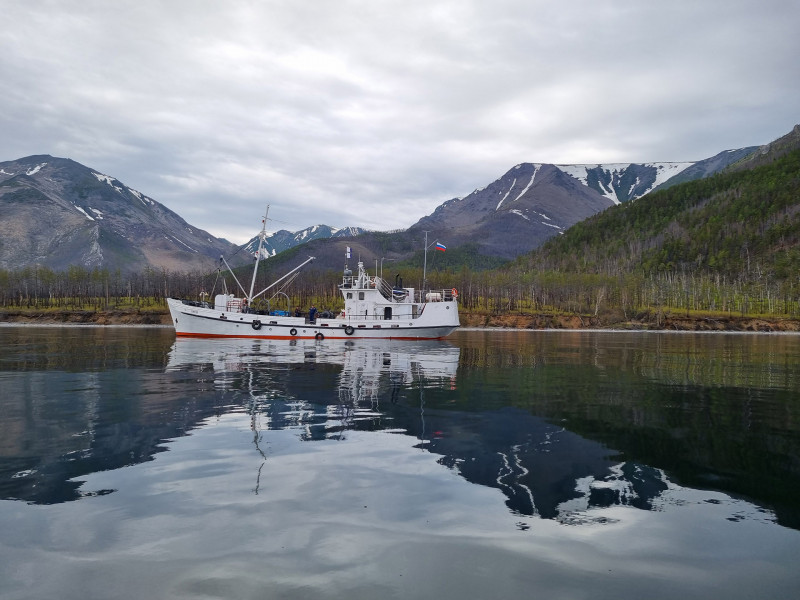Expedition on board the RV “Titov” on June 02-13, 2023
On June 02-13, 2023, a research expedition was carried out on board the RV “Titov”, the main purpose of which was to study the current state of the endemic Baikal spongiofauna in conditions of global environmental change with an assessment of the dynamics of quantitative and qualitative indicators.
The expeditionary works were carried out within the State assignments № 0279-2021-0005 “Study of seasonal and long-term transformations of the state of water bodies and watercourses in East Siberia in the context of climate change, geological environment and anthropogenic loads” (led by A.P. Fedotov), № 0279-2021-0011 “Genomics of symbiosis. Study of interactions between the host and consortia of microorganisms and parasites” (led by S.I. Belikov) and № 0279-2021-0010 “Genetics of communities of Baikal organisms: gene pool structure, conservation strategies” (led by D.Yu. Shcherbakov).
A series of works on the Circum-Baikal Expeditionary Research Work to assess changes in the quantitative and qualitative composition of sponge communities from year to year at control polygons, transects and sponge community monitoring stations and sampling of the Baikal spongelids for laboratory research was continued.
Areas of field works:
| 1 | Listvennichny Bay | 51.850408 | 104.865095 |
| 2 | Ulanovo | 51.789501 | 104.518854 |
| 3 | Varnachka Pad` | 51.897253 | 105.108682 |
| 4 | Olkhonskiye Vorota Strait | 53.002798 | 106.933786 |
| 5 | Ukhan Cape | 53.074140 | 107.407067 |
| 6 | Elokhin Cape | 54.840890 | 108.866811 |
| 7 | Turali Cape | 55.285228 | 109.753957 |
| 8 | Nizhnee Izgolovye of the Svyatoy Nos peninsula | 53.488712 | 108.511128 |
Surface and near-bottom water samples were taken in these areas for further hydrochemical analysis in the laboratory.
To monitor the disease status of the Baikal endemic sponges, quantitative collection of diseased specimens along all transects was carried out. A total of 132 samples of diseased sponges of different species were collected during the expedition.
The collected specimens were described (visual characterization of lesion types - necrosis, discoloration, biofilm, stains, and plaque). All collected specimens were fixed in 70% ethanol and numbered. This collection will result in an analysis of the distribution of lesion types across the lake taking into account the species membership of sponges. Samples of diseased sponges with stains were taken for further analysis under a microscope to describe the type of lesion.
To obtain continuous year-round temperature data in the shallow water zone of the lake (year-round recording of temperatures at transects of the stations in different areas of Baikal (at depths of 6, 12, 15, 30 m) were made, readings were taken and temperature loggers were placed.
During the expedition, underwater photography and video recording of reference sponges, marked earlier in 2015-2016, was conducted in the areas: Varnachka settlement (garden of stones), Ulanovo railway station, Ukhan Cape, Elokhin Cape, and Turali Cape. New healthy specimens of sponges in the area of the Angara River source were marked.
Additionally, in the area of Elokhin Cape (Northern Baikal), we collected using gill nets the samples of spawning males of yellowfin sculpin Cottocomephorus grewingkii of the May stock for further microsatellite analysis and identification of the population structure of yellowfin sculpin.
Within this expedition, from June 04-06, phytobenthos samples were taken in the area of Bolshie Koty settlement. The main object was cyanobacteria of the genera Nostoc and Tychonema. Samples were collected by divers from the surface of bottom soils and sediments as well as in the bottom water layer. Seven samples were collected for mass spectrometric analysis to identify microcystin variants produced by Nostoc and Tychonema in natural environments. Cyanobacteria of the genus Tychonema, like all oscillatorians, have a rather expressed polymorphism; that is why sampling was scheduled for late spring. Two populations of the genus Nostoc were collected: the so-called “Bolshekotinskaya” (biomass 4 kg) and “Malomorskaya” (6 kg). The biomass will be used for the extraction of toxic metabolites and polysaccharides.
Samples of amphipod of the species Spinacanthus parasiticus associated with branched sponges Lubomirskia baikalensis were taken at a depth of 12-17 meters near Ulanovo. The samples were fixed in RNA fixer – RNA intact (Evrogen) for further work with mitochondrial transcripts. Some samples were placed in ethanol for morphological verification of the species. Amphipods of the species Acanthogammarus victorii were collected in the area of Listvyanka at a depth of 6-26 m. The samples were delivered alive to the aquarium of the freshwater aquarium complex of the Baikal hydrobionts at LIN SB RAS. In the future, there are plans to isolate fractions of mitochondria and mitochondrial proteins from these samples for mass spectrometric analysis of their amino acid sequences.






















